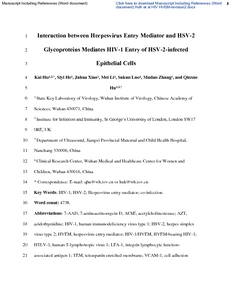Hu, K; He, S; Xiao, J; Li, M; Luo, S; Zhang, M; Hu, Q
(2017)
Interaction between herpesvirus entry mediator and HSV-2 glycoproteins mediates HIV-1 entry of HSV-2-infected epithelial cells.
J Gen Virol, 98.
pp. 2351-2361.
ISSN 1465-2099
https://doi.org/10.1099/jgv.0.000895
SGUL Authors: Hu, Qinxue
![[img]](http://sgultest.da.ulcc.ac.uk/109092/6.hassmallThumbnailVersion/Hu%20K%20et%20al%20JGV%20accepted%20version.pdf)  Preview |
|
PDF
Accepted Version
Available under License ["licenses_description_publisher" not defined].
Download (1MB)
| Preview
|
Abstract
Herpes simplex virus type 2 (HSV-2) increases human immunodeficiency virus type 1 (HIV-1) acquisition and transmission via unclear mechanisms. Herpesvirus entry mediator (HVEM), an HSV-2 entry receptor, is highly expressed on HIV-1 target cells (CD4+ T cells) and may be incorporated into HIV-1 virions, while HSV-2 glycoproteins can be present on the infected cell surface. Since HVEM-gD interaction together with gB/gH/gL is essential for HSV-2 entry, HVEM-bearing HIV-1 (HIV-1/HVEM) may enter HSV-2-infected cells through such interactions. To test this hypothesis, we first confirmed the presence of HVEM on HIV-1 virions and glycoproteins on the HSV-2-infected cell surface. Additional studies showed that HIV-1/HVEM bound to the HSV-2-infected cell surface in an HSV-2 infection-time-dependent manner via HVEM-gD interaction. HIV-1/HVEM entry of HSV-2-infected cells was dependent on HVEM-gD interaction and the presence of gB/gH/gL, and was inhibited by azidothymidine. Furthermore, peripheral blood mononuclear cell-derived HIV-1 infected HSV-2-infected primary foreskin epithelial cells and the infection was inhibited by anti-HVEM/gD antibodies. Together, our results indicate that HIV-1 produced from CD4+ T cells bears HSV-2 receptor HVEM and can bind to and enter HSV-2-infected epithelial cells depending on HVEM-gD interaction and the presence of gB/gH/gL. Our findings provide a potential new mechanism underlying HSV-2 infection-enhanced HIV-1 mucosal transmission and may shed light on HIV-1 prevention.
Statistics
Item downloaded times since 04 Sep 2017.
Actions (login required)
 |
Edit Item |



